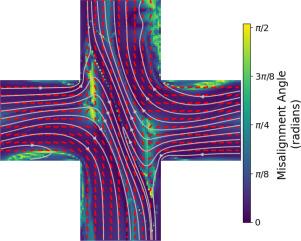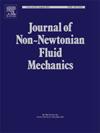跟踪导致非定常交叉槽流动的聚合物取向和流动:高速成像和建模
IF 2.8
2区 工程技术
Q2 MECHANICS
引用次数: 0
摘要
粘弹性流动的不稳定性限制了聚合物的加工速度。高速光学应力和流动测量用于深入了解聚合物取向和流场之间的关系,从而导致粘弹性波动和不稳定性。高摩尔质量的聚乙烯氧化物溶液通过交叉槽几何结构从对称流动转变为不对称流动,并在足够高的流速下不断转换其不对称结构。数据通过同步粒子测速和亚毫秒分辨率的偏振成像获得。采用Giesekus本构模型的三维数值模拟显示了类似的流动切换行为。实验和模拟结果都表明,在流动不对称方向转换之前,流动-聚合物不对准在驻点附近增长。聚合物错位的作用表明了流场中驻点的重要作用,这一认识可能为提高不稳定性的控制提供了更有效的处理方法。本文章由计算机程序翻译,如有差异,请以英文原文为准。

Tracking polymer orientation and flow leading to unsteady cross-slot flow: High-speed imaging and modeling
Viscoelastic flow instabilities limit polymer processing rates. High-speed optical measurements of stress and flow are used to provide insight into the relationships between polymer orientation and flow field that lead to viscoelastic fluctuations and instability. The flow of high-molar-mass polyethylene oxide solutions through a cross-slot geometry transitions from a symmetric flow into an asymmetric flow that continually switches its asymmetric configuration at sufficiently high flow rates. Data was acquired by synchronized particle velocimetry and polarization imaging at sub-ms resolution. Three-dimensional numerical simulations using the Giesekus constitutive model demonstrate similar flow switching behavior. Both experiments and simulations show a growth of flow–polymer misalignment near stagnation points prior to switching of the flow asymmetry direction. The role of polymer misalignment demonstrates the important role of stagnation points in flow fields, and this understanding may suggest ways to improve control of instabilities for more efficient processing.
求助全文
通过发布文献求助,成功后即可免费获取论文全文。
去求助
来源期刊
CiteScore
5.00
自引率
19.40%
发文量
109
审稿时长
61 days
期刊介绍:
The Journal of Non-Newtonian Fluid Mechanics publishes research on flowing soft matter systems. Submissions in all areas of flowing complex fluids are welcomed, including polymer melts and solutions, suspensions, colloids, surfactant solutions, biological fluids, gels, liquid crystals and granular materials. Flow problems relevant to microfluidics, lab-on-a-chip, nanofluidics, biological flows, geophysical flows, industrial processes and other applications are of interest.
Subjects considered suitable for the journal include the following (not necessarily in order of importance):
Theoretical, computational and experimental studies of naturally or technologically relevant flow problems where the non-Newtonian nature of the fluid is important in determining the character of the flow. We seek in particular studies that lend mechanistic insight into flow behavior in complex fluids or highlight flow phenomena unique to complex fluids. Examples include
Instabilities, unsteady and turbulent or chaotic flow characteristics in non-Newtonian fluids,
Multiphase flows involving complex fluids,
Problems involving transport phenomena such as heat and mass transfer and mixing, to the extent that the non-Newtonian flow behavior is central to the transport phenomena,
Novel flow situations that suggest the need for further theoretical study,
Practical situations of flow that are in need of systematic theoretical and experimental research. Such issues and developments commonly arise, for example, in the polymer processing, petroleum, pharmaceutical, biomedical and consumer product industries.

 求助内容:
求助内容: 应助结果提醒方式:
应助结果提醒方式:


